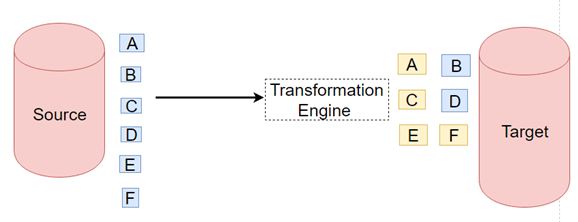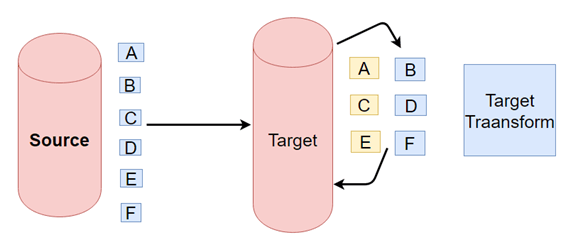ETL

ETL is an abbreviation of Extract, Transform and Load. In this process, an ETL tool extracts the data from different RDBMS source systems then transforms the data like applying calculations, concatenations, etc. and then load the data into the Data Warehouse system.
In ETL data is flows from the source to the target. In ETL process transformation engine takes care of any data changes.
ELT

ELT is a different method of looking at the tool approach to data movement. Instead of transforming the data before it's written, ELT lets the target system to do the transformation. The data first copied to the target and then transformed in place.
ELT usually used with no-Sql databases like Hadoop cluster, data appliance or cloud installation.
Data Warehouse vs Data Lake
ETL对应的是Data Warehouse,而ELT对应Data Lake,那什么是Data Lake?
A data lake is a system or repository of data stored in its natural format, usually object blobs or files. A data lake is usually a single store of all enterprise data including raw copies of source system data and transformed data used for tasks such as reporting, visualization, analytics and machine learning. A data lake can include structured data from relational databases (rows and columns), semi-structured data (CSV, logs, XML, JSON), unstructured data (emails, documents, PDFs) and binary data (images, audio, video).
Pentaho CTO James Dixon has generally been credited with coining the term “data lake”. He describes a data mart (a subset of a data warehouse) as akin to a bottle of water…”cleansed, packaged and structured for easy consumption” while a data lake is more like a body of water in its natural state. Data flows from the streams (the source systems) to the lake. Users have access to the lake to examine, take samples or dive in.
参考:
https://www.guru99.com/etl-vs-elt.html
https://aws.amazon.com/cn/big-data/datalakes-and-analytics/what-is-a-data-lake/
https://www.blue-granite.com/blog/bid/402596/top-five-differences-between-data-lakes-and-data-warehouses
https://www.forbes.com/sites/bernardmarr/2018/08/27/what-is-a-data-lake-a-super-simple-explanation-for-anyone/#672125e776e0
https://blog.panoply.io/etl-vs-elt-the-difference-is-in-the-how
https://www.xplenty.com/blog/etl-vs-elt/